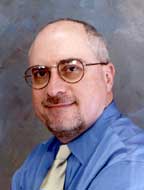- Vol. 3, No. 3: March 2004 – CONTENTS

Upfront
Want to Know What Really Sucks?
Does your marketing suck? According to Mark Stevens, author of the book Your marketing sucks, it does (see “Your Pharma Marketing Sucks” in this issue).
But let me tell you what really sucks…
“It’s the economy, stupid!”
If this “economic recovery” didn’t suck, we wouldn’t be having this conversation about marketing and how much it sucked.
Whether or not pharma marketing sucks, it seems to be working — pharma companies are still making plenty of money and the economy doesn’t seem to be having much of an impact on drug sales.
But what about the rest of us — the “little” guys that service the industry? I’m talking about the ad agencies, the communications companies, the marketing consultants, etc. that make up 45% of Pharma Marketing News subscribers. How are we doing?
I think it could be summed up nicely by “it sucks!” That is, we could be doing a lot better.
Of course, I don’t have any numbers to back that up. It’s just a gut feeling I get talking to and observing many people on this side of the pharma business. I wish I had forty or fifty bucks every time I heard a salesperson at an industry conference ask, “Where are the clients?” It’s just a bunch of us vendors schmoozing around the hors d’oeuvres table. As Mark Stevens says in his book, schmoozers should be fired because the only thing that matters is closing. “Nothing happens until someone sells something,” as he is fond of quoting (not sure whom).
So, where are the clients — the product managers and other purchasers with budgets?
They are in their offices busy at work — extremely busy and over-worked! They don’t even have time for a free lunch! That’s because one thing this recovery has going for it is increased productivity, which means more output from less workers (merger anyone?). And less use of outside agencies and consultants to perform tasks that are now done in house or perhaps outsourced overseas.
I don’t wish the pharma industry ill and I hope it continues to do extremely well. Lately, however, not much of its high profit margin income has trickled down to the pharma service industry, in my opinion. I think it’s the same with other industries-they are not hiring staff or outside help as they once did during better economic times.
I’ve seen heady growth predictions for some pharma marketing sectors such as DTC ad spending for 2004 (see “Key Issues Facing DTC Marketers in 2004” PMN32-01; February, 2004). Even if true, that’s just one segment. We all can’t get on the TV DTC gravy wagon!
So, the economy sucks and there’s less low hanging fruit to go after. That’s life. In order to deal with the hand we’ve been dealt and get our share of the available crumbs out there, we really can’t afford to have marketing that sucks. We have to engage in some “extreme marketing” as Mark suggests in his book.
How do we do this? One way is to use the power of our Network to improve our closing rate.
I have some ideas how to do this and I intend to speak with Pharma Marketing Network members at venues like the Networking Cocktail Reception (April 7, 2004 in Princeton, NJ) to test my ideas and refine them.
If I help you succeed, then I succeed as well. That’s what Pharma Marketing Network is all about. See you in Princeton!

![]()
John Mack, Publisher and Editor
editor@pharmamarketingnews.com
Article Summaries
FEATURE ARTICLE
Scenarios on the Future of Pharma Marketing: No Time Like the Present to Think the Unthinkable
By John Mack
This article summarizes a presentation made by Jane Sarasohn-Kahn, a health economist and forecaster, at the Strategic Research Institute’s 2nd Pharmaceutical Marketing Global Summit held in Philadelphia, PA, February 24 through 26, 2004.
In her talk, Ms. Sarasohn-Kahn assessed the prospects for the pharmaceutical industry over a 1 to 5 year period. She identified and analyzed the key external drivers shaping the short and longer-term futures of pharma, including political, economic, the provider market, plans, payers/employers, and e-business, among them. Based on these futures, Ms. Sarasohn-Kahn offered actionable implications for pharmaceutical marketers.
More…
Order the Full Article Reprint – $6.95
PMN33-01
Issue: Vol. 3, No. 3: March 2004
Word Count: 1351
TOPICS: Strategic Planning
SURVEY
Pharmaceutical “Cause Marketing”
An article in the March 10, 2004 issue of the Wall Street Journal entitled “Behind the ‘Boomer Coalition,’ a Heart Message from Pfizer” characterized pharmaceutical funding of disease awareness programs “cause marketing.”
This survey asks your opinion on this technique and its role in customer relationship building in pharma.
Take the survey at: Survey Form
You can see the aggregate results from all respondents after taking the survey!
SEMINAR HIGHLIGHT
Medical Science Liaisons: Working between Two Worlds
By Mark Schmukler
Medical Science Liaisons (MSLs) have assumed a pivotal role interfacing between pharmaceutical and biotechnology companies and the opinion and thought leaders (OTLs) who influence how medicine is routinely practiced. These professionals offer the OTL the credibility and objectivity of a peer, but also provide an insider’s knowledge of their companies and products. Their ability to coordinate the flow of clinical information and manage important relationships can be critical to a product’s success at any stage of its life cycle.
This article, which is a review of the seminar, Best Practices for Medical Science Liaisons held in Princeton, New Jersey, in January, 2004, highlights how MSLs can maximize their unique position to help improve medical care while they enhance their companies’ bottom lines.
More…
Order the Full Article Reprint – $9.95
PMN33-02
Issue: Vol. 3, No. 3: March 2004
Word Count: 1371
TOPICS: Key Opinion Leader Management/Medical Science Liasion | Physician Marketing



![6 Digital Tools at the Center of Healthcare Digitalization [INFOGRAPHIC]](http://ec2-54-175-84-28.compute-1.amazonaws.com/pharma-mkting.com/wp-content/uploads/2021/04/6DigitalTools_600px-218x150.jpg)




![6 Digital Tools at the Center of Healthcare Digitalization [INFOGRAPHIC]](http://ec2-54-175-84-28.compute-1.amazonaws.com/pharma-mkting.com/wp-content/uploads/2021/04/6DigitalTools_600px-100x70.jpg)




